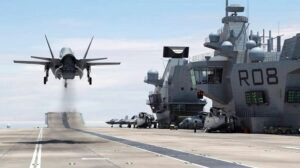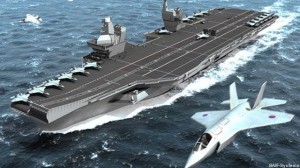UK Commits To 2 Carriers, Fully Crewed; F-35B Numbers TBD
Posted on

A computer-generated image of a Royal Navy F-35B taking off vertically from the new carrier HMS Queen Elizabeth.
WASHINGTON: The United Kingdom is committed to a high-end battle fleet centered on two aircraft carriers, a senior Ministry of Defense official made clear yesterday. Just as important, the UK is committed to funding adequate crews to sail them — something that had been in doubt after much discussion about cutting costs by effectively mothballing the second carrier, HMS Prince of Wales, once it was built.
And Britain will not change its mind again. These are non-negotiable commitments not subject to revision by the ongoing Strategic Defense & Security Review (SDSR), Minister of State for Armed Forces, Penny Mordaunt, told reporters late yesterday. What’s still up in the air in the review, however, is how many F-35B Joint Strike Fighters the Royal Navy will buy for the two carriers, Prince of Wales and Queen Elizabeth.

Penny Mordaunt
“The decision to have two carriers was taken prior to the SDSR, and for my money, that was absolutely the right decision,” Mordaunt said. “We have made certain assumptions going into the SDSR about…some of the things that we think are fundamental and we have already committed to.”
“Manning them is very much already factored in to the Navy’s manning plan,” Mordaunt went on. Finally, there’s “investment that’s going in, actually not a stone’s throw away from my own constituency [northern Portsmouth], to enable…general maintenance to be done much more quickly.” To save costs, the Queen Elizabeth class has a fewer sailors for its size than older ships, she said, but it requires “additional shore support” to compensate.
Carriers are inherently maintenance-hungry, which is why Britain is building two in the first place: to ensure at least one is always ready to deploy, even if the other is in overhaul. “There’s no point in having a capability that you can’t rely on,” Mordaunt said, “and you need at least two carriers to be able to guarantee that you can use [one] when you need them.”
Of course, aircraft carriers aren’t much use without aircraft, either. Each QE-class ship can accommodate 40 aircraft of various types, but not all of those are going to be fighters. (Indeed, the British are planning to operate Queen Elizabeth with nothing but helicopters until its first F-35s are delivered). The maximum capacity for F-35s is reportedly 36 aircraft, but during routine operations, each carrier might have only a dozen F-35Bs on board.
Will each carrier eventually get a full complement of F-35s? “Any sort of further commitments on details… whether it’s numbers of aircraft or numbers of frigates or what have you, that will be coming out of the SDSR process,” Mordaunt said. “But what I would say [is that in the SDSR] there will also be a lot of radical thinking about the kinds of things we will be operating… .from the carriers,” not just F-35s but “other air assets, whether they’re manned or unmanned..”
One of the savviest aerospace industry analysts around guesstimated the British would end up with 30 F-35Bs per carrier — eventually. “60 Bs, that would probably do the job,” Richard Aboulafia told me.
“The original buy of 138 F-35s [for the Royal Navy and RAF combined] looks unlikely,” Aboulafia said. “If we’re looking at acquisitions through 2030, with some F-35s acquired to replace earlier Eurofighters, we’ll likely see at least 100 UK F-35s”: 60 Bs for the Royal Navy and 40 As for the Royal Air Force.
(The F-35A is a conventional land-based aircraft that requires a runway, while the B-model is a “jump jet” like the famous Harrier, with the ability to take off and land vertically on a much smaller deck. At one point the British planned to buy the conventional carrier-launched variant, the F-35C, but the requisite upgrades to the flight deck were too expensive).
A Royal Navy reservist herself, Mordaunt made clear in her remarks yesterday to the Atlantic Council that the fleet was a top priority.
“We are a maritime nation,” she said. “If those pinch points are closed, in a few days we will be in deep trouble. 90 percent of everything that we use as fuel, as goods, is brought to the UK by sea. So this is an absolute priority for us.”
What’s more, Britain has prioritized warfighting over low-intensity operations, accepting a smaller fleet as the price of more capable vessels that can keep pace with the US Navy. “These are the most sophisticated warships in the world,” Mordaunt boasted at the Atlantic Council. They also “are probably the most expensive warships in the world,” she acknowledged, somewhat ruefully.
“You can buy a frigate for half the price that the Type 26s are going to cost us,” Mordaunt said, but it wouldn’t have half the capability. Likewise, the Type 45 destroyer is much more expensive and powerful than alternative designs, she said: “We have chosen to buy billion-pound warships because it makes us relevant to the US.”
Subscribe to our newsletter
Promotions, new products and sales. Directly to your inbox.
